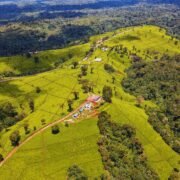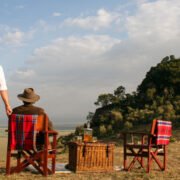
Laikipia vs. Samburu: Which Northern Kenya Safari Destination is Right for You?
Introduction: Two Distinct Worlds of Northern Kenya
When planning a safari in Kenya, the Masai Mara often takes center stage. But for the discerning traveler seeking exclusivity, unique wildlife, and immersive experiences, Northern Kenya holds unparalleled allure. Two regions—Laikipia and Samburu—stand out for their raw beauty, diverse landscapes, luxury safari camps, and deep conservation roots.
But how do you choose between them? Each offers distinct advantages, rare species, and cultural interactions. In this guide, Stawi Adventures takes you on a deep dive into Laikipia vs. Samburu, comparing wildlife, landscapes, activities, lodges, and conservation models to help you decide—or inspire you to experience both!
Wildlife: Rare Species and Iconic Encounters
Laikipia: Big Five Stronghold and Rhino Haven
Laikipia is home to some of Kenya’s most robust rhino populations, including:
- Over 50% of Kenya’s black rhinos
- The last two northern white rhinos on Earth at Ol Pejeta Conservancy
It’s also home to:
- The Big Five: lion, leopard, elephant, buffalo, and rhino.
- African wild dogs, one of Africa’s most endangered predators.
- Grevy’s zebras and reticulated giraffes, overlapping with Samburu’s species.
Laikipia’s private conservancies mean low visitor numbers and intimate encounters, with off-road drives and night safaris enhancing the experience.
Samburu: Desert-Adapted Wildlife and the Samburu Special Five
Samburu’s arid ecosystem nurtures species found nowhere else in Kenya:
- Grevy’s zebra (narrow-striped)
- Reticulated giraffe (distinctive patchwork)
- Beisa oryx (elegant desert antelope)
- Gerenuk (long-necked antelope that browses standing upright)
- Somali ostrich (blue-necked)
In addition, elephants, lions, leopards, crocodiles, and hippos thrive along the Ewaso Nyiro River.
Comparison Summary:
- Laikipia: Best for Big Five, rhinos, and wild dogs.
- Samburu: Best for desert-adapted species and the Samburu Special Five.
Landscapes: A Contrast in Scenery
Laikipia: Diverse and Lush
Laikipia stretches across:
- Rolling savannahs
- Riverine forests
- Escarpments and rocky outcrops
- Mount Kenya views
Its higher altitude provides cooler temperatures and varied ecosystems, from acacia-studded plains to forested hills.
Samburu: Arid Beauty
Samburu offers:
- Semi-desert landscapes
- Rocky kopjes (outcrops)
- Dry riverbeds crisscrossing the land
- The Ewaso Nyiro River, a green ribbon of life
The region’s hot, dry climate gives it a rugged charm, with dramatic sunsets and stunning contrasts between the river’s lush banks and the surrounding arid plains.
Comparison Summary:
- Laikipia: Diverse, with savannahs, forests, and mountain views.
- Samburu: Arid, rugged, and uniquely desert-like.
Safari Activities: More Than Game Drives
Laikipia: Adventure Capital
- Horseback safaris: Ride alongside giraffes and zebras.
- Camel trekking: Explore at a slower pace.
- Walking safaris: Track wildlife on foot.
- Mountain biking: For thrill-seekers.
- Night game drives: Spot nocturnal species.
- Rhino tracking on foot: Engage in conservation efforts firsthand.
Samburu: Classic with Cultural Depth
- Game drives: Along Ewaso Nyiro’s riverbanks.
- Walking safaris: Offered in private conservancies.
- Cultural visits: Engage deeply with Samburu communities.
- Camel safaris: Available in select camps.
- Night drives: Offered in conservancies like Kalama and Westgate.
Comparison Summary:
- Laikipia: More adventure-oriented with a range of activities beyond game drives.
- Samburu: Focuses on classic safaris with strong cultural immersion.
Conservation Models: How Your Safari Supports Wildlife
Laikipia: Private Conservancy Pioneers
Laikipia’s conservancy model balances wildlife protection and community benefits. Lodges contribute directly to:
- Rhino conservation
- Anti-poaching patrols
- Community schools and healthcare
- Sustainable grazing programs
Examples:
- Ol Pejeta Conservancy: Famous for rhino conservation and the Sweetwaters Chimpanzee Sanctuary.
- Lewa Wildlife Conservancy: A UNESCO World Heritage Site supporting both wildlife and local communities.
Samburu: Community-Led Conservation
In Samburu, many conservancies are community-owned:
- Sera Conservancy: Operated by Samburu communities, home to Saruni Rhino and Kenya’s first rhino tracking experience.
- Kalama and Westgate Conservancies: Jointly managed with local Samburu, blending cultural preservation and wildlife conservation.
Comparison Summary:
- Laikipia: A mix of private and community partnerships, focused on rhino protection and Big Five conservation.
- Samburu: Primarily community-led, fostering cultural empowerment alongside wildlife protection.
Luxury Lodges: Where Comfort Meets Wilderness
Laikipia’s Top Lodges:
- Lewa Wilderness: Heritage luxury with horseback safaris and scenic flights.
- Borana Lodge: Overlooking Mount Kenya, known for rhino tracking and eco-luxury.
- Ol Pejeta Bush Camp: A Big Five conservancy experience with a focus on conservation.
- Loisaba Tented Camp: Offers star beds and camel safaris.
Samburu’s Top Lodges:
- Saruni Samburu: Cliffside villas with panoramic views and Samburu Warrior Academy.
- Sasaab Lodge: Moorish-inspired architecture, plunge pools, and camel rides.
- Saruni Rhino: Exclusive rhino tracking on foot in Sera Conservancy.
Comparison Summary:
- Laikipia: Lodges emphasize eco-adventure, horseback safaris, and rhino conservation.
- Samburu: Lodges focus on cultural immersion, camel safaris, and desert beauty.
Cultural Experiences: Engage with the Heart of Kenya
Laikipia: Maasai and Samburu Interactions
Many Laikipia conservancies border Maasai and Samburu lands, offering:
- Visits to Maasai villages.
- Learning about livestock management alongside wildlife conservation.
Samburu: Deep Cultural Immersion
Samburu offers deeper cultural exchanges:
- Village visits with Samburu elders explaining traditions, beadwork, and rites of passage.
- Opportunities to join traditional dances or learn warrior skills.
Comparison Summary:
- Laikipia: Offers diverse cultural encounters with both Maasai and Samburu.
- Samburu: Provides deep, authentic engagement with the Samburu culture.
Travel Logistics: Getting There and When to Go
Getting There:
- Laikipia:
- Fly to Nanyuki or private airstrips at Lewa, Ol Pejeta, or Loisaba.
- Road transfers available from Nairobi (4-6 hours).
- Samburu:
- Fly to Samburu airstrip (near Samburu National Reserve) or Kalama airstrip for conservancies.
- Road transfers from Nairobi (6-7 hours).
Best Time to Visit:
- Laikipia: Year-round. Cooler due to higher altitude; excellent dry season sightings (June to October).
- Samburu: Best in the dry seasons (June–October, December–March), with concentrated wildlife around water sources.
Suggested Itinerary: Combine Both for the Ultimate Safari
- 3 Nights in Samburu (Saruni Samburu)
- Explore Samburu Special Five and cultural experiences.
- Camel rides and game drives.
- 4 Nights in Laikipia (Borana Lodge + Ol Pejeta Bush Camp)
- Rhino tracking, horseback safaris, and Big Five viewing.
- Scenic flights over Mount Kenya.
- Optional Extension to Lewa Wilderness
- End with horseback safaris and cultural exchanges.
Conclusion: Which Destination Is Right for You?
- Choose Laikipia if:
You want Big Five safaris, rhinos, wild dogs, Mount Kenya views, and adventure activities like horseback riding and biking. - Choose Samburu if:
You’re drawn to arid landscapes, unique species (Samburu Special Five), and deep cultural immersion with the Samburu people. - Combine both for the ultimate Northern Kenya safari:
Let Stawi Adventures craft a bespoke itinerary, blending Laikipia’s diversity with Samburu’s raw beauty.
Contact Stawi Adventures today to plan your luxury Northern Kenya safari and experience the best of both worlds.






